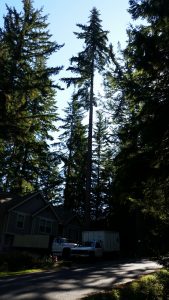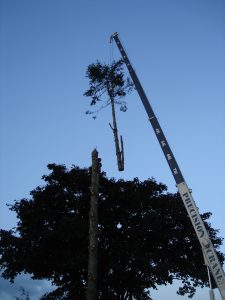Medicinal Uses of Pine Trees
 Evergreens are also known as conifers. They make up the bulk of a group of plants called gymnosperms. In my home area we have one conifer that is not evergreen: Larch or Tamarack (Larix). You can also find the deciduous Bald Cypress (Taxodium distichum) under cultivation. The broadleaf gymnosperm Ginkgo biloba is often planted, but this article will stick to the conifers (Pinophyta). “Gymnosperm” means “naked-seed,” which means that the female part is exposed so that it can be directly pollinated by the male pollen that blows to it on the wind. The angiosperms that are responsible for all the beautiful flowers like Tulips and Roses have female parts that are enclosed and must be reached by the male pollen through the complexity of the flower.
Evergreens are also known as conifers. They make up the bulk of a group of plants called gymnosperms. In my home area we have one conifer that is not evergreen: Larch or Tamarack (Larix). You can also find the deciduous Bald Cypress (Taxodium distichum) under cultivation. The broadleaf gymnosperm Ginkgo biloba is often planted, but this article will stick to the conifers (Pinophyta). “Gymnosperm” means “naked-seed,” which means that the female part is exposed so that it can be directly pollinated by the male pollen that blows to it on the wind. The angiosperms that are responsible for all the beautiful flowers like Tulips and Roses have female parts that are enclosed and must be reached by the male pollen through the complexity of the flower.
Recognizing a gymnosperm is relatively easy. Look for the “Pine Trees” (or, more properly, the conifers). But take note that while many refer to any conifer, or evergreen, as a Pine Tree there are really three botanical families represented in our area: the Pine, Cypress, and Yew families. So, “Pine” means “Pinus” and “Pine family” means “Pinaceae.” As this is my first SurvivalCache article on the subject, I am focusing on the area I know best- the Northeast (particularly that which is centralized in the New York, New Jersey, and Pennsylvania tri-state area, or the Delaware River valley) to discuss some species and introduce some basic botany and survival considerations. For future posts I will discuss other regions of the country.
The Pine family contains several genera. Pinus (Pine), Picea (Spruce), Abies (Fir), Tsuga (Hemlock), and Larix (Larch) are found in our area. Pseudotsuga menziesii (Douglas-fir) and some others (including non-indigenous Pine) can be found in cultivation. I regularly use White Pine, which is partially due to it being more common in my area than the other Pines. I also commonly make use of Hemlock, which is a primary tree of certain forests and the host of one of my favorite medicinal mushrooms, Ganoderma tsugae (Reishi). This is a very useful plant family for the survivalist to get to know.
The Cypress family has Taxodium (Bald Cypress), Thuja (Arbor-vitae), Chamaecyparis (Atlantic White-cedar), and Juniperus (Juniper and Red Cedar). There are many medicinal uses of species in Cupressaseae, but it should be regarded as less edible in general than the Pine family. Thuja essential oil, for instance, is considered quite toxic.
The Yew family is mostly found in landscapes as our native Taxus (Yew) is over-browsed by deer. English and Japanese domestic varieties are quite common under cultivation and sometimes naturalize (spread into the wild from cultivation). Yews are toxic.
So, to avoid poisoning, the beginner should quickly learn the difference between Yews and the others, especially the Hemlock and Fir that superficially resemble Taxus because of the leaf (needle) arrangement. The red “berry” of Taxus is edible, but not the seed (which is actually visible, indicating it is a gymnosperm, in the cup-shaped “berry”). It is very common for poisonous plants to concentrate toxins in the seeds while producing an innocuous fruit.
The Pines and Yews have needles while the Cypress family has scale-like leaves. (One exception to this generalization is Bald Cypress, which has needle-like leaves that alternate on deciduous terminal twigs.) They are all needle-like in a way, but you will notice the scale quality in the Cypress family, such as with Juniperus or Thuja. If you then learn to recognize the Yew needles (which are rare in the wild anyway), the remainder varieties of needles can be known as belonging to members of the Pine family.
Pinaceae – Pine Family
Pinaceae is the representative family of the gymnosperms, as the group consists of the most quintessential evergreen trees. They tend to be pitchy (they have thick, sticky, aromatic sap), with a piney or citrus-like scent. Their leaves are needles. And they have the most quintessential cones (often called “pine cones” no matter what genus they occur on, even if the genus is of another family), compared to the berry-like cones of Juniperus and Taxus (Yew), for instance. The cones have spirally arranged scales and the seeds have wings.
One of the easiest ways to get to know this family of trees is to get to know the individual genera: Pinus, Tsuga, Picea, Larix, and Abies of our area. Cedrus and Pseudotsuga are native to other parts of the country. Cathaya, Pseudolarix, Keteleeria, and Nothotsuga are native to China.
scotch_pinePinus sylvestris (Scotch Pine or Scot’s Pine) is the most widely distributed Pine. It was brought here from Europe and can normally be found along driveways and cultivated lands. It can be easily distinguished from the other common species by its orange-shaded upper bark and the light blue-green of its needles. It has been used extensively in traditional European medicine and has also been used for pharmaceutical preparations.
The Ojibwa used Jack Pine (Pinus banksiana) to to revive consciousness. Arthritis, muscle pains, sores, wounds, and pains associated with colds and febrile illnesses have all been treated with various Pinaceae species. Our most common native species, White Pine (Pinus strobus) and Pitch Pine (P. rigida) have been used extensively as wild food and medicine. Pines were a primary dietary supplement for winter as a source of vitamin C and to treat coughs, colds, and fevers.
tsuga_canadensis_adelgesHemlock (Tsuga canadensis) has horizontally arranged needles with white stripes (giving a pale appearance on the underside) that are dark green above and have been important for survival in the Northeast similar to Pinus.
Hemlock is a common tree of stream gorges. It hosts a species of Reishi (Ganoderma tsugae) and is being attacked by a devastating insect, the Wooly
Adelgid. The cones are quite small and persist so that they are often found dried but still on the tree. The genus name is from Japanese. The common name is shared with Poison Hemlock (Conium maculatum), which causes a deal of confusion in some circumstances. Poison Hemlock, being in the Carrot Family (Apiaceae) is not very closely related at all.
Balsam Fir (Abies ballsamea) is used for coughs, colds, cuts, and sores. Its taste and aroma is quite pleasant. I would use Fir species much more commonly, except they are not abundant locally. Those in the Western states might readily fine useful and interesting Abies species nearby.
Tamarack (Larix laricina) is used for stomach, colds, coughs, fatigue, sores, soreness, and infections; and as a tonic for general health, laxative, and diuretic. Chippewa used infusion of bark for anemic conditions and poultice of inner bark for burns.
The various species of Spruce (Picea) have been used like others from the Pine Family for colds and other general uses. The pitch in particular is favored as fire-starting material and for topical medicinal application, such as in the case of boils, infections, and cuts.
Cupressaceae – Cypress Family
red_cedar_saplingRed Cedar (Juniperus virginiana) This is by far the most common representative of this family and genus in our area. Common Juniper (J. communis) can also be found, but is not so common (despite its name) due to habitat loss and deer browse and is easily differentiated from Red Cedar in that it is a low-growing, spreading shrub. Red Cedar is much more tree-like, though it can’t compete in our peak forests. Sometimes you will find significant numbers dying in the shade of taller trees. Healthy stands are found in old fields and similar locations. They have dark blue berry-like cones.
A Red Cedar sapling that died after getting shaded out by taller-growing trees. The small, dead twigs are easy to remove to turn the tree into a staff , handle, or utility pole.
TAXACEAE – Yew Family
yew_cross_sectionTaxaceae includes only three genera worldwide, only one of which, Taxus, which occurs in this country. Of the nine (estimated) species of Taxus in the world, three can be found wild in the region- one of which is native: T. canadensis. It is the only species found wild in the immediate area, but is suffering from deer overbrowse. The most common place to find Yew is in hedgerows where it is commonly planted. A friend cut down a hedge in Hawley, PA. A slice of one trunk that I have here on the table has 47 growth rings and is only four finger-widths thick (see image below). Particularly in the Northwest, Yew is a favorite wood for bows.
It is easy to recognize Yew by the bright red berries (arils), which (as it is a gymnosperm) are open on the end, exposing the seed.
The flesh of the fruit is the only edible part of the plant, but the seeds are highly toxic. T. canadensis and Pacific Yew (T. brevifolia) are used to make a pharmaceutical drug Taxol that is used to treat cancer. Natives used Yew to treat numbness in the fingers. Yew species can be recognized by their lack of aromatic properties that are present in Pinaceae and Cupressaceae.
This article is from a friend of mine, Tim Bento, owner of Ascending Tree Service. Thank you Allen, for the great article. It is intended for information only. Do your own research before engaging in any of the activities mentioned in the article.

